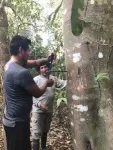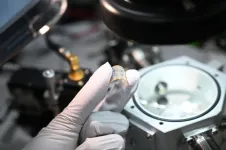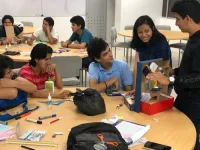(Press-News.org) For hundreds of years, the Amazon has been exploited for its gold. Today, the precious metal is just as sought after, but the remaining tiny gold particles are much harder to find. Mining often happens in artisanal and small-scale mining operations that release mercury (Hg) into the air, polluting the environment and harming human health.
An international team of researchers has now examined tree rings of species native to the Peruvian Amazon to determine if trees could be used to show approximately where and when atmospheric mercury was released.
“We show that Ficus insipda tree cores can be used as a biomonitor for characterizing the spatial and potentially the temporal footprint of mercury emissions from artisanal gold mining in the neotropics,” said Dr Jacqueline Gerson, an assistant professor in biological and environmental engineering at Cornell University and first author of the study published in Frontiers in Environmental Science. “Trees can provide a widespread and fairly cheap network of biomonitoring, by archiving a record of mercury concentration within tree bolewood.”
Mercury is in the air
For gold extraction, miners add mercury to the soil that contains tiny gold particles. Mercury binds to the gold particles which creates amalgams. Amalgams have a much lower melting point than gold so to extract it, the amalgams are burned. This process releases gaseous mercury into the atmosphere.
Three neotropical tree species with previously documented annual tree rings were examined to test their potential as biomonitors: Wild figs (Ficus insipida), a common tree in the neotropics, Brazil nuts (Bertholletia excelsa), and tornillos (Cedrelinga catenaformis). Due to the equitable year-round climate in the neotropics, not all trees form rings, and of the examined species, only F. insipida exhibited them. Tree cores samples were collected at two sites far from mining activity and three sites within five kilometers to mining towns where amalgams are frequently burned. One of the mining sites was next to protected forest.
“There are many variables that drive individual tree Hg concentrations, and it is difficult to determine the specific drivers,” Gerson explained. “The trees in the study were all the same species and from the same sites, exposed to the same atmospheric Hg concentration. That is why we sample multiple trees and then use average values.”
Mercury concentrations in bolewood were highest at the two sampling sites close to mining activity and lower at the mining-impacted site adjacent to protected forest and the sites far from mining towns. “Higher atmospheric Hg concentrations are generally associated with nearby mining locations,” Gerson explained. “In the Peruvian Amazon, where mining is the main source of Hg, the association between higher Hg concentrations and proximity to a mining site can readily be drawn.”
Especially after 2000, Hg concentrations near towns rose where mercury-gold amalgams were burned. “This is likely due to the expansion of gold mining activities around this time,” Gerson said.
A network of spies
While the study proved that trees can be used as a biomonitoring network for gaseous mercury emissions, the study has some limitations. Most notably, the exact distance to mining towns was unknown due to the illegal nature of these operations. This likely influenced the concentrations of Hg found in the trunk wood.
“Ficus insipida can be used as a cheap and powerful tool to examine large spatial trends in Hg emissions in the neotropics,” Gerson concluded. “Using bolewood could allow for regional monitoring efforts.” This is particularly important in relation to the UN Minamata Convention on Mercury, an international treaty which aims to reduce mercury and mercury compound emissions and mitigate health and environmental risks.
END
Trees could be spying on illegal gold mining operations in the Amazon rainforest
By examining mercury concentrations in tree rings, researchers showed that trees could be witnesses to illegal gold mining activities in the Amazon, highlighting their potential as biomonitors
2025-04-08
ELSE PRESS RELEASES FROM THIS DATE:
Even after a thousand bends, performance remains uncompromised!
2025-04-08
The research team led by Dr. Jongwon Yoon, Dr. Jeongdae Kwon, and Dr. Yonghoon Kim from the Energy & Environmental Materials Research Division at the Korea Institute of Materials Science (KIMS), has successfully developed the world’s first ammonia (NH₃) gas sensor based on a copper bromide (CuBr) film that can be fabricated through a simple solution process at low temperatures. This breakthrough technology not only enables sensor flexibility, ultra-sensitivity, and high selectivity but also significantly reduces manufacturing costs.
Ammonia gas sensors detect airborne ammonia and are utilized in indoor and outdoor ...
Survey: Women’s perceptions of perimenopause
2025-04-08
Hot flashes, mood swings, weight gain and insomnia are all signs of hormonal changes and symptoms of menopause, when a woman no longer has menstrual cycles. They can also signal perimenopause, when the body is preparing for this next season of life.
“Perimenopause is when the menstrual cycle has started to change, and it is persistent,” explained Lauren Baker, DO, an obstetrics and gynecology physician at The Ohio State University Wexner Medical Center and certified practitioner with the Menopause Society. “The formal definition is periods fluctuate by at least seven days for at least 10 months.”
A new survey by Ohio State ...
Singapore scientists pioneer non-invasive 3D imaging to transform skin cancer management
2025-04-08
SINGAPORE – Researchers from the Agency for Science, Technology and Research (A*STAR) and the National Healthcare Group (NHG) have jointly pioneered an innovative imaging technique combining Multispectral Optoacoustic Tomography (MSOT) with artificial intelligence (AI) that could significantly improve the diagnosis and treatment of basal cell carcinoma (BCC), the most common form of skin cancer worldwide.
This advanced technique uses photoacoustic imaging (PAI), enhanced by an automated segmentation algorithm, to provide real-time, high-resolution, three-dimensional (3D) images of skin tumours. By accurately mapping tumour boundaries, ...
Powerful new tool promises major advances in cancer treatment
2025-04-08
New Australian technology is set to transform the way that gastrointestinal cancers are detected and treated with precise, minimally invasive surgery.
Backed by the Federal Government’s Economic Accelerator (AEA) Ignite Grant, researchers from the University of South Australia (UniSA) are using quantum technology to develop a first-of-its-kind laparoscopic probe that will allow surgeons to accurately map the spread of tumours.
The technology has the potential to improve cancer survival rates and patient quality of life worldwide.
Led by Dr Nicole Dmochowska from UniSA’s ...
Inflammation and the brain: how immune activity can alter mood and fuel anxiety
2025-04-08
FOR IMMEDIATE RELEASE
Physicians have long observed a mystifying phenomenon: After a bout of infection or an autoimmune disease flare-up, some people experience prolonged mood swings, emotional dysregulation, and changes in behavior. But the precise connection between inflammation, mood, and behavior has remained elusive.
Now, two new studies from Harvard Medical School and Massachusetts Institute of Technology, published April 7 in Cell, detail the steps of an intricate brain-immune crosstalk that accounts for this long-known but poorly understood observation.
The work, conducted ...
Researchers demonstrate the UK’s first long-distance ultra-secure communication over a quantum network
2025-04-07
Researchers have successfully demonstrated the UK’s first long-distance ultra-secure transfer of data over a quantum communications network, including the UK’s first long-distance quantum-secured video call.
The team, from the Universities of Bristol and Cambridge, created the network, which uses standard fibreoptic infrastructure, but relies on a variety of quantum phenomena to enable ultra-secure data transfer.
The network uses two types of quantum key distribution (QKD) schemes: ‘unhackable’ encryption keys hidden inside particles of light; and distributed entanglement: a phenomenon that causes quantum particles to be intrinsically ...
One in 3,000 people at risk of punctured lung from faulty gene – almost 100 times higher than previous estimate
2025-04-07
As many as one in 3,000 people could be carrying a faulty gene that significantly increases their risk of a punctured lung, according to new estimates from Cambridge researchers. Previous estimates had put this risk closer to one in 200,000 people.
The gene in question, FLCN, is linked to a condition known as Birt-Hogg-Dubé syndrome, symptoms of which include benign skin tumours, lung cysts, and an increased risk of kidney cancer.
In a study published today in the journal Thorax, a team from the University of Cambridge examined data from UK Biobank, the 100,000 Genomes Project, and East London Genes & Health – three large genomic datasets encompassing more than ...
Creativity and problem-solving: How design thinking transforms university teaching
2025-04-07
Thinking creatively, solving complex problems, and working in teams… all add up to Design Thinking (DT). A study conducted by the Escuela Superior Politécnica del Litoral (ESPOL) and Ghent University provides a step-by-step guide for teaching this methodology as a university course.
The main objective of this study is to share the implementation of DT in the first year of all undergraduate programs at ESPOL, considering that previous research has shown that this course fosters essential DT skills in a world of constant change, allowing students to build their own knowledge through experiential learning.
In practice, this study ...
American College of Cardiology recognizes 2025 Young Investigator Award recipients
2025-04-07
The American College of Cardiology is recognizing the 2025 winners of its Young Investigator Awards, which took place at the ACC’s Annual Scientific Session (ACC.25) in Chicago.
The Young Investigator Awards competition invites promising, young scientific investigators to present their cutting-edge research. The finalists competed in three categories: Basic and Translational Science, Clinical Investigations and Outcomes Research. This year’s awardees are:
Young Investigator Awards in Basic ...
Coding differences in Medicare Advantage plans led to $33 billion in excess revenue to insurers
2025-04-07
Embargoed for release until 5:00 p.m. ET on Monday 7 April 2025
Follow @Annalsofim on X, Facebook, Instagram, threads, and Linkedin
Below please find summaries of new articles that will be published in the next issue of Annals of Internal Medicine. The summaries are not intended to substitute for the full articles as a source of information. This information is under strict embargo and by taking it into possession, media representatives are committing to the ...
LAST 30 PRESS RELEASES:
Exposure to natural light improves metabolic health
As we age, immune cells protect the spinal cord
New expert guidance urges caution before surgery for patients with treatment-resistant constipation
Solar hydrogen can now be produced efficiently without the scarce metal platinum
Sleeping in on weekends may help boost teens’ mental health
Study: Teens use cellphones for an hour a day at school
After more than two years of war, Palestinian children are hungry, denied education and “like the living dead”
The untold story of life with Prader-Willi syndrome - according to the siblings who live it
How the parasite that ‘gave up sex’ found more hosts – and why its victory won’t last
When is it time to jump? The boiling frog problem of AI use in physics education
Twitter data reveals partisan divide in understanding why pollen season's getting worse
AI is quick but risky for updating old software
Revolutionizing biosecurity: new multi-omics framework to transform invasive species management
From ancient herb to modern medicine: new review unveils the multi-targeted healing potential of Borago officinalis
Building a global scientific community: Biological Diversity Journal announces dual recruitment of Editorial Board and Youth Editorial Board members
Microbes that break down antibiotics help protect ecosystems under drug pollution
Smart biochar that remembers pollutants offers a new way to clean water and recycle biomass
Rice genes matter more than domestication in shaping plant microbiomes
Ticking time bomb: Some farmers report as many as 70 tick encounters over a 6-month period
Turning garden and crop waste into plastics
Scientists discover ‘platypus galaxies’ in the early universe
Seeing thyroid cancer in a new light: when AI meets label-free imaging in the operating room
Neutrophil-to-lymphocyte ratio may aid risk stratification in depressive disorder
2026 Seismological Society of America Annual Meeting
AI-powered ECG analysis offers promising path for early detection of chronic obstructive pulmonary disease, says Mount Sinai researchers
GIMM uncovers flaws in lab-grown heart cells and paves the way for improved treatments
Cracking the evolutionary code of sleep
Medications could help the aging brain cope with surgery, memory impairment
Back pain linked to worse sleep years later in men over 65, according to study
CDC urges ‘shared decision-making’ on some childhood vaccines; many unclear about what that means
[Press-News.org] Trees could be spying on illegal gold mining operations in the Amazon rainforestBy examining mercury concentrations in tree rings, researchers showed that trees could be witnesses to illegal gold mining activities in the Amazon, highlighting their potential as biomonitors





